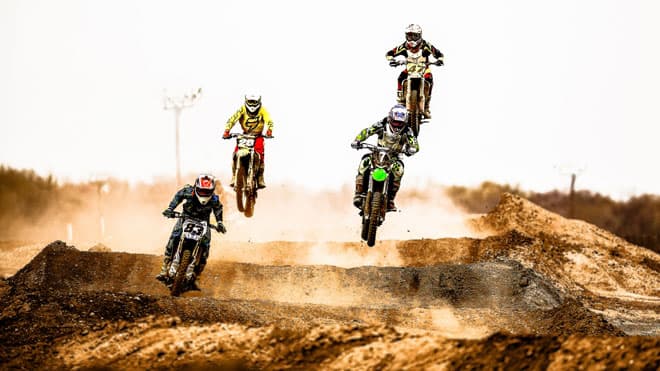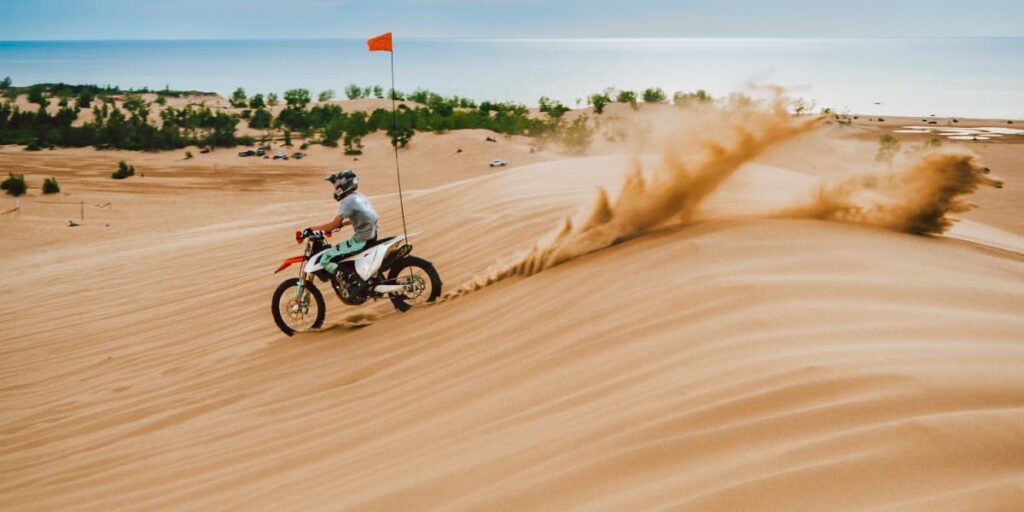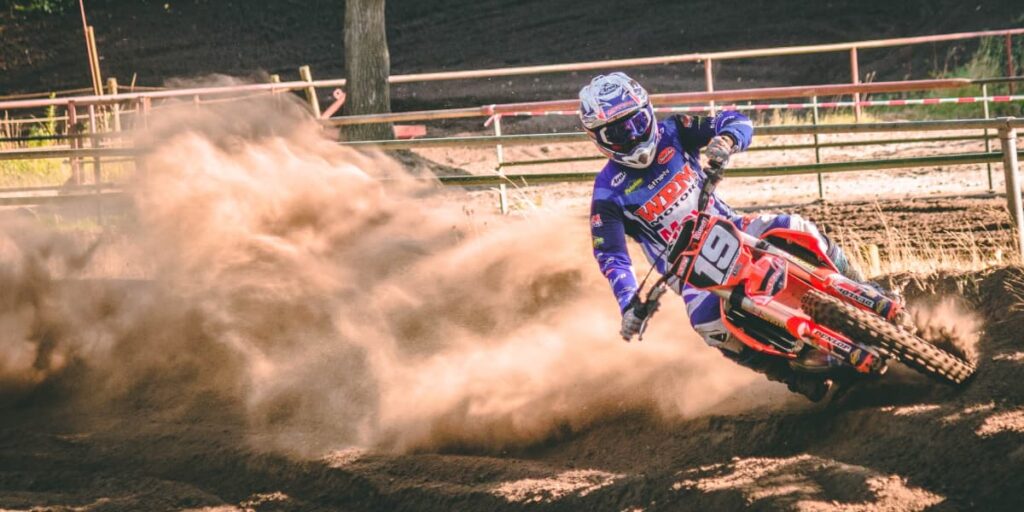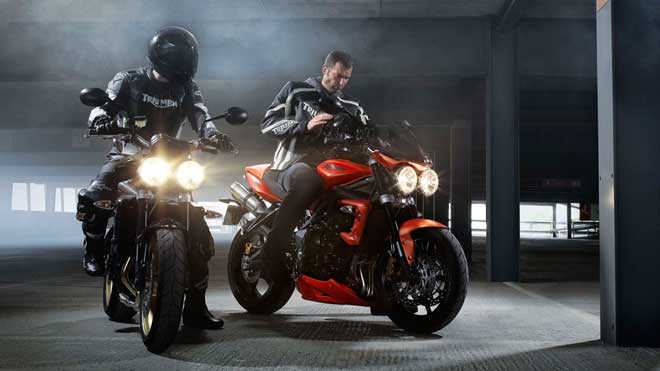Many riders have asked me, “where are the best places to go for intermediate and advanced cyclists?”.
Many people were confused; when I started riding dirt bikes, I became confused as well. It is essential to realize that what works for beginners might not work for advanced riders.
Sand and dunes
The sand ride is a lot of fun, particularly on dunes of Sand. It’s a lot of fun when you ride on a vast sandy dune that is secure, so if you fall, you’ll not cause significant damage to your body. This is particularly suitable for those who are new to riding.
But a weak layer of Sand can be very hazardous and can result in injuries in a tragic accident as Sand is difficult to navigate on, mainly when it’s thin. It is also dependent on the slope, and if it’s a steep slope and highly narrow, it is hazardous. Overall, I suggest that beginners be insured and adhere to the safety guidelines.
Brawley, California – This is my favorite area in California and is one of the most popular destinations for riding and has five miles of dunes. There are three levels of moderate and low difficulty.
The ideal moment to go on a bike is during the winter, fall, and early spring months because this desert region can reach over 100 degrees in summer. It is possible to camp in the area.
I would not advise riders who are just beginning to ride to ride there, and only those who have already mastered the fundamentals of riding dirt bikes ought to attempt to ride there. It’s an incredible place for those who love riding through dunes.
Grass
It is an excellent choice for those just beginning, even on thin or twisty layers. The only drawback is that it’s challenging to access areas designed for grass, and I’ve discovered only two regions.
Forest
Many novices believe that they’re competent enough and that their riding skills aren’t as good, and after a while, they think they’re ready to begin riding in the woods, and they’re wrong.
The forest is one of the most dangerous areas for novice riders because of the number of stones and rocks in the ground. There is also the possibility that you’ll hit a tree that could cause the breaking of hands or a leg and, in the worst scenario, a loss of consciousness and possibly an ambulance trip.
The woods are only suitable for experienced bike riders that have been training for a long time. However, beginner riders can explore some very particular forests on dirt bikes.
Wayne National Forest, OH Wayne National Forest in Ohio is one of my favorite places that I’ve been to. There are miles of fantastic trails, and the entrance fee is around $20. Wayne National Forest, OH, is an excellent choice for beginner riders and advanced riders, and I would highly recommend it for riding.
Western Washington Capitol Forest – The next destination is for those more advanced and who want to take on a challenge. Western Washington Capitol Forest is one of the most popular spots for dirt bikes, with its base of approximately 80 kilometers of trails and riding terrain.
The forest is accessible from April 30 through December 1 each year. The forest itself is beautiful. I would highly recommend Western Washington Capitol Forest as it’s a great place for cyclists to test their riding skills.
Tracks
The dirt tracks can be among the top spots for beginner riders to learn, mainly when supervisors well maintain them. Some ways are suitable for beginner riders and tracks for advanced riders, even kids!
Parks
Parks are undoubtedly one of the most enjoyable places to ride in, particularly with many lands. And, no, I’m not talking about public parks, and these are parks specifically designed for dirt bikes.
They’re one of the most suitable locations to start for newbies. There are parks designed for advanced, intermediate, and novice riders, so it is essential to watch this. Additionally, it is crucial to have permission if you are riding in public parks, as you could face fines if you don’t. I would recommend this site:
Moses Lake Sand Dunes/ORV Park WA A fantastic spot to ride in is Moses Lake Sand Dunes / ORV Park, WA. It’s got around 3000 miles of dunes made of Sand (located near the southern part of Lake Moses) and about 3000 miles of trails; however, it’s only accessible from July 1 until October 1. The park is ideal for all kinds of riders. The park also has lakes and fishing and camping areas. I highly would recommend this location as a place to visit with families.
Snow
Many riders would like to take a ride, but it’s cold for most of the year in their countries. It is believed that snow is best for intermediate riders and isn’t appropriate for all riders.
The snowy conditions are hazardous for those who have not experienced riders. I understand the fear for those living in areas where it is snowy.
Rain
Many riders ask me about rain. I say it’s safe for dirt bikes. However, it could undoubtedly be damaged when you don’t take the proper precautions. Rainfall is generally suitable for advanced or intermediate riders.
How to Riding Your Dirt Bike Well on Sand?
Balance is the key.
One of the first things they advise you before hopping on riding your dirt bicycle is to ensure balance, and this is true whether you’re riding on gravel or a flat surface.
It’s the only method to ensure you stay in the top position during the entire ride. But, the kind of balance required to be able to ride in Sand is much more advanced.
It is essential to ensure that you’re in perfect balance and control so that you can stand up to the sudden incline of your Drz400 motorcycle. One way you can use to keep your balance is by getting off the dirt motorcycle.
This will ensure less pressure on the front tire for effortless navigation. It is essential not to override the bike as it could cause you to lose your balance.
Also, you must grip your handlebars with a loose grip and use your weight to control your bike. That’s how you can ride through the Sand on dirt bikes without slipping off as often as an armory.
Maintain the Engine
Sometimes, not even the top dirt bike will stop you from experiencing difficulties riding through the Sand. It is, therefore, necessary to think things through to figure out the best method to stay afloat.
The most frequent mistake made is stopping the bike when encountering the road, which only leads to more risk of getting into trouble. Therefore, the engine must be on continuously, making it easy to control the bike and steer it properly.
The bike is also lighter, making it simple to get out of a bind. This is one of the critical guidelines for sand riding. Make sure you are riding at the right speed and focus your eyes on the road.
You’ll have an easy time on the bike, and you’ll be able to avoid a variety of issues like becoming stuck in the Sand.
Improve the use of your Legs
Cleanly riding in Sand relies on your entire body, and most crucially, your legs. There are many situations when you’ll have to lay both legs down to ensure that your bike is upright.
Also, it is essential to use only one leg to lift the bike away from a short tilt and prevent it from crashing into the ground. This is where an accessory for motorcycles like the nudge bar is valuable, and it will ensure the safety of both you and your bike.
In places where you cannot keep a certain pace, you need to use your legs to pull your bike forward. This is the only way you’re going to make it through the ride on your dirt bike in the sandy terrain.
Remember that the majority of your balance is derived from your legs, your hands, and your general location when riding in these situations. The inability to utilize your legs will result in difficulty reaching your destination.
Learn to get out of difficult Places
The most important thing you don’t want is to be stuck in the wilderness because you’re unsure how to navigate your way out of the tight places. Some of the more difficult places include sandy dunes, sand ditches, and even sand storms.
This is the reason. If you’re looking for a dirt motorcycle for auction, you must take a look at some of the necessary accessories for a bike. If you are stuck, you should begin moving your body so that you end up having less mass.
Do not engage the clutch, at least not this moment, and never again, as this is the way people create more issues while sand riding. It is also essential to ensure that the throttle is set at its lowest. These factors will make it easy for you to have a great way to get out of difficult situations.
Certain situations require you to take your bike off and drag it away from the Sand. When you reach the point where you need to get off, do it to prevent extending your time there.
Keep Practicing
You may be one of the top dirt bikers; however, if you don’t practice riding Sand, it will only be the same as a novice in this type of circumstance. Training will help you become more proficient and proficient.
There are many blogs on strategies for riding Sand, but if you’re not in this challenging position, it will not be of any use. Put the knowledge to the test by identifying the areas that have Sand.
Start by riding with less Sand when you move to places with more Sand. It will be apparent that you are having difficulty when you advance, and this is when you’ll learn to adapt your riding abilities.
By following the advice above and the above tips, you should ride on Sand with no issues. But, keep practicing to experience what it is like.
Be sure to shield the airbox and filter out dust, adjust the suspension of your wheels, and install paddle tires when it is possible to do so in the rear of the wheel.
If you follow these tips, it is possible to ride smoothly without stopping to avoid an unexpected jam. Once you have gained knowledge, you’ll find Sand riding enjoyable.
How do I ride a Motorcycle in the Dirt?
Make sure your motorcycle is prepared for Dirt.
If you’ve already learned how to drive a motorcycle but you’d like to venture off-road on a dirtbike, or another dual-purpose vehicle, here are ten tips to consider while you’re transitioning from road to trails.
Like you would with an ordinary bike and a motorcycle, you’ll need to utilize the Motorcycle Safety Foundation’s TCLCS checklist to ensure that your bike is prepared to go.
However, hitting Dirt may cause tire pressure to drop (sometimes up to 20 pounds or more) to allow the rubber to become more flexible about the terrain. It’s recommended to get rid of saddlebags and other accessories which could make you feel heavier or cause shakes because of the vibrations. Additionally, it would help if you considered tucking in or removing turn signals, windscreens and mirrors since they are likely to be damaged when you get a spill.
Gear Up!
Dirt can be soft; however, offroad accidents could be a severe cause of injury because your body’s a delicate thing. Like road riding, selecting the appropriate protective gear, from helmets to boots, is essential for protecting yourself.
Offroading gear is quite a lot from road gear since boots are longer and feature more reinforcement on shins. The shoulders, knees, chest (aka the roost deflector), and elbows (not visible here) are typically covered with jerseys and lightweight pants.
Gloves tend to be lightweight and flexible to allow for the varying range of motion related to offroad riding and motocross or Dirt helmets. They have a sunshade and an area to put goggles in. I guarantee you that one trip along a dirt trail will cause you to appreciate the goggles that keep Dirt from your eyes.
Loosen Up
It’s crucial not to stiffen up while riding on roads; however, how you loosen is an entirely new dimension while offroad. Because of the unpredictable nature of surface conditions as well as the increased travel of suspensions and a lack of traction, your body is either able to deal with the vibrations of a dirtbike’s jiggling shifting, heaving, or swaying… and, simply put, it makes it more likely you’ll fall.
Check yourself before you head out for the Dirt. Shake out your body and ensure you’re as fit as you can and ready to take on the punches. If you don’t, it’s too easy to fall out of the flow and the vital connection to your bike.
Standing up Lowers Your Center of Gravity
The bike’s center of gravity typically lies around the engine, and when the rider sits on the saddle, that point is elevated.
Everyone knows that an increased center of gravity can make a bicycle top-heavy and difficult to move.
Even though sitting on the pegs in the feet might sound odd, it lowers their center of gravity by a significant amount because all of your weight rests upon the footpegs. This is why about three-quarters of offroading involves sitting on pegs. The process of moving bikes around restricted spaces is much simpler when you’re off of the bike’s seat.
Some tips to stand up on your bike:
- Place your feet on the feet and not on the heels. The brake and shifter pedals are a little out of reach this way, and it’s a lot easier to grasp the bike’s mechanics.
- Relax the tank by rubbing your thighs. This can give you a better feeling of lean angle and help you keep your bike in check.
- Use your knees to absorb shock to ensure that you don’t fall off your bike.
- Use your elbows to steer, and you’ll have more freedom when the road is bumpy.
Fear No Obstacles
Street riders are naturally inclined to have the instinct to steer clear of obstacles and for a good reason. Most street bikes lack enough suspension to absorb massive shocks. However, dirt bikes can traverse over logs the mud and travel every kind of ridge or rut.
It can take a while to come to terms with the fact that you can cross that obstacle, but the feeling will be at peace once you travel it. Make sure you cross the barrier within your path at an angle of 90 degrees; so that your tire will not get stuck.
Additionally, dirtbikes can raise their front wheels more easily than street bikes, which can be accomplished by simply moving the throttle and pulling the handlebars. On that note, be sure to use the acceleration to your advantage. If you stall, you’ll quickly get stuck and miss a chance.
Be an averse driver when you are braking.
One thing you’ll need to learn in Dirt is stopping an automobile. The braking process on paved roads is mainly done using the front brake. About 70% of the lever effort goes to the front because the weight shifts into the front of the vehicle when it starts to slow.
But, Dirt can present utterly different traction patterns because it’s simple to “wash out” or “tuck” the front wheel because of slippage of the tires. You’ll have to think in reverse and put most of your efforts into your rear brake. As you can see above, the rear brake is a natural way to get rid of speed when you’re off-road.
Repeat the slides several times to get an idea of what it’s like to ensure that you don’t get surprised to encounter a situation that requires panic braking… as well avoid those roads unless you’re sure it won’t get washed out.
Reverse your thinking when turning
Road racers are taught to lean forward into turns, and race fans know that relying upon the bike in the middle of a turn reduces the bike’s center of gravity. However, it’s different in Dirt.
Countersteering, for instance, could put you into some problems because it creates more space for slippage of the tires and the eventual risk of destruction. Instead of leaning in turn, place your body weight onto the outer of the peg as shown here and then shift towards the outside of the turn so that it creates the most force possible on the wheels. It can take some time to get used to, but after you feel how secure the bike is with the way that turns, this will become quick.
Take a Leg Off and Throw it in the Air.
After wrapping your mind around turning the Dirt, an additional element to the whole process is to provide a sense of security that is throwing out a leg.
First, let’s clarify that this isn’t an appropriate method for heavy bikes. Most adventure tours and dual-purpose motorcycles can be hefty enough to break bones if they fall onto your leg.
Many dirtbikes aren’t heavy enough to put a risk to a boot that’s not fully stretched. Put it in the boot, and you’ll be able to have some protection and be capable of holding the bike upright in the event of a crash.
Have fun with this Slip ‘n Slide
When we travel on our roads, it’s important to set ourselves to ensure we have a firm grip on the road, and the experience of tire slips is a bit disconcerting when it can sneak upon us. When riding on Dirt, however, sliding is part of how we live. The bike’s path is fluid, shifting, and changing based on various factors, and skilled dirt riders can cause severe swings and yaw angles without even thinking about it.
Removing yourself from the fear that you will slide may be a complicated process; however, the only way you can get comfortable with the feeling of gliding across the Dirt is to practice it and accept that losing traction will be part of your thrill. Learn this skill, and you’ll be able to tackle one of the most difficult challenges on the off-road trail.
You’ll Fall
Due to the abundant supply of concrete, curbs automobiles, and other road hazards, crashing into public roads can be traumatic. Dirt, however, does not cause as much. Although wearing safety gear is equally essential off-road as on the street, the risks that come with crashes are much lower in Dirt. But, losing traction or riding over obstacles and the possibility of falling off is a regular aspect of dirtbike riding, and it’s among the inevitable events that you need to be prepared for.
Do Dirt Bikes be used on Water?
Dirt bikes can be ridden on the Water using the help of specially designed tires. Many people have been successful in this feat with specific changes to their bicycles. Also, yes, you can too.
Do Dirt Bikes Function On Snow?
Dirt bikes can work in snow, so long as you “winter-proof” the bike. You can also ride your dirt bikes on snow so long as you keep it winterized.
How do I prepare My Dirt Bicycle For Winter?
- Clean it off.
- Then, fill your tank up and ensure that your fuel is stable.
- Change the oil
- Charge your battery
- Make sure you have antifreeze on hand.
- Place it on a bike or stand for ATVs as long as possible.
To sum up
In the end, we walked through the entire area and conditions. I would suggest riding dirt bikes.
There’s only how much you can learn by yourself. Try the motorcycle safety foundation’s dirt bike course to learn offroad techniques from experts.








